
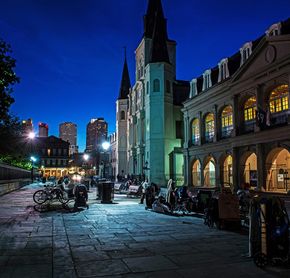
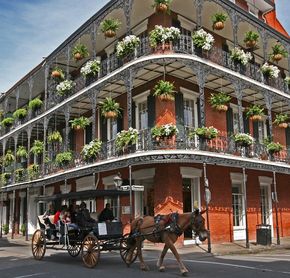
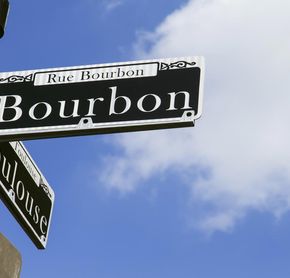

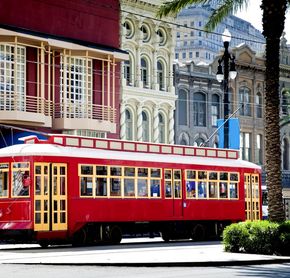
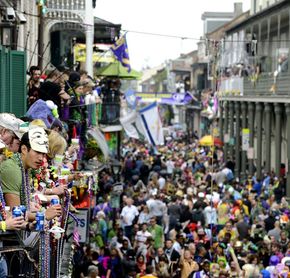
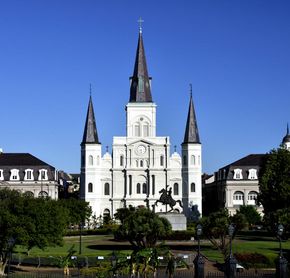
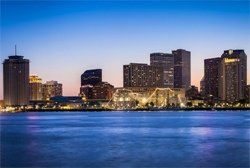 Also known as NOLA and the Big Easy, New Orleans is an iconic Southern U.S. city and the largest metropolis in Louisiana.
Also known as NOLA and the Big Easy, New Orleans is an iconic Southern U.S. city and the largest metropolis in Louisiana.
Known for its round-the-clock nightlife, vibrant live-music scene and famous Mardi Gras festivities, New Orleans also has a rich and unique culture and history.
It is the birthplace of jazz and home of many musical legends such as Louis Armstrong and Sidney Bechet.
Add to this a gourmet cuisine and the charm of old Creole neighborhoods, and it is hard not to be seduced. As they say in Louisiana: "Laissez le bon temps rouler" ("let the good times roll")!
French Quarter (Vieux Carré)
 The French Quarter is the historic heart of the city and the neighbourhood the most heavily frequented by tourists. You simply must explore this must-see historic district, famous for its ornate architecture, colourful buildings and wrought-iron balconies. Experience the colour and excitement of iconic Bourbon Street. Walk down Royal Street, one of the most beautiful streets in the French Quartier with its antique shops and art galleries, until you reach green Jackson Square. Venture inside the jazz clubs on Frenchmen Street. In front of soaring St. Louis Cathedral, street musicians entertain from morning to night. It won't take you long to discover the festive atmosphere for which the city is famous.
The French Quarter is the historic heart of the city and the neighbourhood the most heavily frequented by tourists. You simply must explore this must-see historic district, famous for its ornate architecture, colourful buildings and wrought-iron balconies. Experience the colour and excitement of iconic Bourbon Street. Walk down Royal Street, one of the most beautiful streets in the French Quartier with its antique shops and art galleries, until you reach green Jackson Square. Venture inside the jazz clubs on Frenchmen Street. In front of soaring St. Louis Cathedral, street musicians entertain from morning to night. It won't take you long to discover the festive atmosphere for which the city is famous.
Bound by Mississippi, Iberville Street, Rampart Street and Esplanade Avenue
Ride a streetcar!
www.neworleans.com/plan/transportation/streetcars |
Beauregard-Keyes House and Garden Museum
Beauregard-Keyes House is a historic residence located in the French Quarter. Built in 1826, it is currently a museum focusing on some of the past residents of the house, most notably Confederate General Pierre Gustave Toutant Beauregard and American author Frances Parkinson Keyes. Keyes purchased the property in the 1940s and restored it to its present state, spending winters there until her death in 1970. The house features portraits and souvenirs of Beauregard as well as the writing studio and collections of Keyes. The gardens are also worth a visit. 45-minute guided tours start on the hour, Monday-Saturday from 10 am to 3 pm.
1113 Chartres Street, New Orleans
Gallier House
This Creole-American house, built in 1860, is the former residence of James Gallier Jr, a prominent New Orleans architect. You will marvel at the Victorian furnishings and decor that reflect the opulence of the 19th-century upper class. Its owners clearly enjoyed a comfortable lifestyle with the latest in household technology. Portraits of Mr. and Mrs. Gallier overlook the Rococo Revival double parlor while authentic toys and games can be seen in the children's bedroom. Reservations required.
1132 Royal Street, New Orleans
Pontalba Building
The Pontalba buildings on Jackson Square in the French Quarter are often referred to as the oldest apartment buildings in the U.S. They combine the fascinating history and unique architecture of New Orleans. Built in 1850, the four-story red brick buildings contain apartments, stores and restaurants. 1850 House, a museum in the Lower Pontalba building, displays furnishings and decorative objects and offers a glimpse of upper-middle-class life in the mid-19th century (523 St. Ann Street).
1008 N Peters Street, New Orleans
French Market
Occupying the same site since 1791, the historic French Market is a symbol of pride for the people of New Orleans. What started out as a Native American trading post on the banks of the Mississippi is now a cultural and commercial treasure. Today, the oldest public market in the United States also plays an important role in the local economy. Several stores and restaurants now occupy the renovated buildings, while there is still a large open-air market, as in the 19th century.
N. Peters Street and Decatur Street, between Jackson Square and Barracks Street
Jackson Square
Set in the heart of the French Quarter, Jackson Square, formerly known as Place d'Armes, is one of New Orleans' most recognizable landmarks. This historic park, a National Historic Landmark since 1960, was named for Andrew Jackson (1767-1845), 7th president of the United States and a general in the Battle of New Orleans in 1815. An equestrian statue in his honour stands in the middle of the park. The heart of the city in the colonial era, the square is now surrounded by restaurants and stores and is very popular with street artists and vendors.
Bound by Chartres Street, St. Ann Street, Decatur Street and St. Peter Street
The Presbytère
The Presbytère in Jackson Square was built in 1791 on the former site of the residence of the Capuchin monks. The building was initially used for commercial purposes until 1834, when it became a courthouse. Today it houses a museum featuring two permanent exhibits: one on the history of the colourful Mardi Gras celebration and the other on Hurricane Katrina, with tales of rescue, rebuilding and renewal.
751 Chartres Street, New Orleans
Hurricane KatrinaHurricane Katrina, one of the most powerful hurricanes in American history, struck the Louisiana coast on August 29, 2005. When Katrina hit New Orleans’ badly engineered levee system, it caused a terrible disaster, flooding 80% of the city. About 1,836 people lost their lives during Katrina or in the floods that followed. The material damage has been estimated at more than 108 billion dollars. |
St. Louis Cathedral
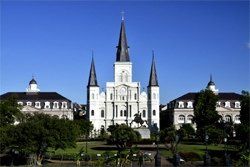 Next to the Presbytère stands the St. Louis Cathedral, also known as "Basilique Saint-Louis-Roi-de-France", which dominates Jackson Square with its three towering steeples. Inaugurated in 1851, it is the 3rd Roman Catholic church to stand on the site since 1718, and the second-oldest cathedral in continuous use in the United States. The exterior is truly impressive, but be sure to go inside to discover all its beauty.
Next to the Presbytère stands the St. Louis Cathedral, also known as "Basilique Saint-Louis-Roi-de-France", which dominates Jackson Square with its three towering steeples. Inaugurated in 1851, it is the 3rd Roman Catholic church to stand on the site since 1718, and the second-oldest cathedral in continuous use in the United States. The exterior is truly impressive, but be sure to go inside to discover all its beauty.
615 Père Antoine Alley, New Orleans
The Cabildo
The Cabildo in the French Quarter's Jackson Square stands next to St. Louis Cathedral and near the Presbytère. It was rebuilt under the Spanish colonial administration in the late 18th century after the Great New Orleans Fire. The Cabildo was the site of the Louisiana Purchase transfer ceremonies in 1803, which finalized the acquisition of the territory of Louisiana by the United States. Several important events have taken place here, from historic court cases to visits by international ambassadors. The building, which belongs to the Louisiana State Museum, now displays exhibits about the history of Louisiana.
701 Chartres Street, New Orleans
Steamboat cruise
A steamboat cruise is certainly one of the most typical experiences you can enjoy in New Orleans. In addition to travelling back to the days when it was common to take a leisurely excursion on the peaceful waters of the Mississippi River, you will see the most beautiful sights and views of New Orleans from the decks of the steamboat. You can complete your experience with a Cajun buffet lunch to the sound of live jazz music. It is also possible to visit the boat's machine room. There are several cruise options to choose from. Reservations are necessary.
400 Toulouse, New Orleans
Royal Street
This elegant street in the French Quarter is the ultimate shopping destination. It is inhabited by family-owned antique shops and art galleries on the ground floor of early 19th century houses, as well as plenty of good restaurants. Just a block away from the festivities of Bourbon Street, Royal Street is the perfect place to unwind or take a relaxing stroll. The section from Canal Street to Esplanade Avenue is the most frequented by tourists.
New Orleans Historic Voodoo Museum
This is a truly unique and interesting small museum. Wander through the two dim rooms filled with offering-covered altars, relics, masks and other artifacts related to the world of voodoo. The history of voodoo is closely entwined with that of New Orleans and Louisiana. The arrival of black slaves led to the emergence of new religious practices, some of which are still practiced today, complete with mysteries, folklore, ritual and voodoo dolls. The museum is run by a voodoo priest who sometimes offers readings. You may be lucky enough to meet his python!
724 Dumaine Street, New Orleans
Bourbon Street
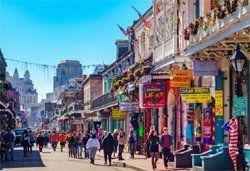 A visit to New Orleans wouldn't be complete without an evening visit to Bourbon Street. This raucous street is alive with music and revelry all year round, and especially around Mardi Gras in February.
A visit to New Orleans wouldn't be complete without an evening visit to Bourbon Street. This raucous street is alive with music and revelry all year round, and especially around Mardi Gras in February.
It's a street of excess! Largely quiet during the day, the street comes alive at night. Soak in the colours, lights, music, bars, strip clubs, street musicians, restaurants and souvenir shops. Stop for a drink, try on carnival masks, let your hair down and have fun!
Preservation Hall
 Preservation Hall was created in 1961 to protect, preserve and perpetuate the spirit of traditional New Orleans jazz. Located in the heart of the French Quarter, the venue presents intimate, acoustic jazz concerts every night. Don't judge the quality of the musicians by the appearance of the building! The venue is tiny, but you're sure to have a memorable evening. There are usually 100 places available each night, only 40 of which are seated. . VIP seats can be booked ahead of time: the price is higher, but you'll be guaranteed good seats and avoid the lineup. Visit the website.
Preservation Hall was created in 1961 to protect, preserve and perpetuate the spirit of traditional New Orleans jazz. Located in the heart of the French Quarter, the venue presents intimate, acoustic jazz concerts every night. Don't judge the quality of the musicians by the appearance of the building! The venue is tiny, but you're sure to have a memorable evening. There are usually 100 places available each night, only 40 of which are seated. . VIP seats can be booked ahead of time: the price is higher, but you'll be guaranteed good seats and avoid the lineup. Visit the website.
726 St. Peter Street, New Orleans
The Historic New Orleans Collection
This museum, research centre and publisher is dedicated to the preservation of the history and culture of the region. Among other things, it provides free exhibitions at its Royal Street and Chartres Street campuses. The Royal Street campus houses the Williams Gallery temporary exhibits, the permanent installation, the Louisiana History Galleries, and the Williams Residence museum. The exhibits present the multicultural history of the region, the development of Louisiana, its different architectural styles, and more. 45-minute guided tours are available.
533 Royal Street, New Orleans
Warehouse District
The Warehouse District is the center of artistic activity in New Orleans. The warehouses built near the banks of the Mississippi River in the early 19th century have been transformed into studios, apartments and museums. In addition to museum visits, be sure to take a stroll along Julia Street, which is home to a large number of contemporary art galleries. This urban neighborhood will delight art lovers.
Between Poydras Street and Pontchartrain Expressway
Confederate Memorial Hall Museum
Confederate Memorial Hall Museum opened its doors in New Orleans in 1891 and has been commemorating the military history and heritage of the South for more than 120 years. It houses a magnificent collection of paintings, photographs, uniforms and other American Civil War memorabilia, such as personal items that belonged to Robert E. Lee, Stonewall Jackson and Jefferson Davis.
929 Camp Street, New Orleans
National World War II Museum
This military museum tells the story of the American experience in World War II. The museum's mission is to explain why it was fought, how it was won, and what it means today, so that all generations will understand the price of freedom and be inspired by what they learn. You will learn about military history and about the different operations carried out by the Americans. There is also a large exhibit of vintage aircraft, tanks and personnel carriers.
945 Magazine Street, New Orleans
Blaine Kern’s Mardi Gras World
 If you don't visit New Orleans in February during the world-famous Mardi Gras Carnival, make a stop at Blaine Kern's museum. There you'll get a glimpse of the fever that fills the city streets during the festivities and learn about the creation of the lavish parade floats Blaine Kern has been building since 1947. There are guided tours regularly. Call and ask if there is a free shuttle from your hotel.
If you don't visit New Orleans in February during the world-famous Mardi Gras Carnival, make a stop at Blaine Kern's museum. There you'll get a glimpse of the fever that fills the city streets during the festivities and learn about the creation of the lavish parade floats Blaine Kern has been building since 1947. There are guided tours regularly. Call and ask if there is a free shuttle from your hotel.
1380 Port of New Orleans Place, New Orleans
Garden District
Take a stroll through the Garden District, an area less frequented by tourists, where you will discover beautiful Victorian houses and their magnificent gardens. These beautiful homes belonged to sugar and cotton plantation owners before the American Civil War.
Bound by St-Charles Avenue, Jackson Avenue, Magazine Street and Pleasant Street
Magazine Street
Magazine Street is a busy thoroughfare that stretches for some 10 km. You will find many unique stores to buy locally crafted items as well as clothing boutiques, specialty shops, art galleries, restaurants and cafés. It's a nice street to wander and do some shopping.
St. Charles Avenue
St. Charles Avenue is a magnificent street lined with old oak trees and grand antebellum mansions. It is here, between Canal Street and Carroliton Avenue, that the famous green streetcar of the same name passes. Don't hesitate to hop aboard to explore this charming avenue.
Audubon Nature InstituteAudubon Nature Institute is a non-profit organization that operates several museums and parks dedicated to nature. The institute's mission includes exhibiting the diversity of wildlife, preserving native Louisiana habitats, educating the public about the natural world, conducting research, and entertaining its visitors. It operates a zoo, an aquarium, an insectarium, a theater, a centre for research of endangered species, a species survival centre, a nature centre and three parks. Audubon ZooDiscover life in the Louisiana bayou as well as animals from around the globe. With the many activities geared towards children, the kids are sure to love it! In addition to the animals, you can cool off at Cool Zoo, the zoo's splash park, take a carousel ride or climb aboard the Swamp Train for a scenic tour. Open daily from 10 am to 5 pm. Audubon ParkThis former sugar cane plantation is now a popular recreational area that stretches from St. Charles Avenue to the Mississippi River. It features several playgrounds, picnic shelters, a 2-km jogging path, a lagoon, a golf course, riding stables, tennis courts, a swimming pool and majestic old oak trees. Audubon Aquarium of the AmericasLocated at the end of Canal Street, next to the French Quarter, this aquarium transports visitors to an underwater world. It is home to more than 3,600 animals from more than 250 species. You will be amazed by the 400,000-gallon Gulf of Mexico exhibit. Watch for sea turtles throughout the aquarium, many of which are preparing to be released into the wild. An IMAX theater with a curved screen shows interesting films. (1 Canal Street). |
New Orleans City Park
This 1,300-acre outdoor oasis has been enchanting New Orleans locals and visitors alike since 1854. Stroll through the world's largest stand of mature live oaks, which includes a grand oak that dates back nearly 800 years! It's the perfect place to go for a bike ride, do some jogging or enjoy a walk. The park houses the New Orleans Museum of Art, the New Orleans Botanical Garden, the Besthoff Sculpture Garden, several tennis courts and a golf course. Kids love the miniature train, the Storyland playground and Carousel Gardens Amusement Park with its one-of-a-kind antique wooden carousel.
Bound by Wisner Boulevard, City Park Avenue, Marconi Drive and Robert E Lee Boulevard
New Orleans Botanical Garden
The City Park Rose Garden opened its doors to the public in 1936. In the early 1980s, it was renamed the New Orleans Botanical Garden. Twelve hectares of gardens and art await you. The site showcases the Art Deco work of three artists: architect Richard Koch, landscape architect William Wiedorn and sculptor Enrique Alférez. It contains more than 2,000 varieties of plants from across the globe.
5 Victoria Avenue (Oscar J. Tolmas Building), New Orleans
New Orleans Museum of Art (NOMA)
NOMA opened its doors in 1911. This museum is the oldest institution of fine art in New Orleans and houses an impressive collection of about 40,000 pieces. While it is reputed for its French and American art, the collection also features photography, glass and African and Japanese art. The museum's treasures include a set of works by French Impressionist painter Edgar Degas, who visited New Orleans in the early 1870s, as well as paintings and sculptures by Picasso, Braque, Dufy and Miro. You can explore the collection online before your visit. The museum is open Tuesday-Sunday from 10 am to 5 pm and the sculpture garden daily from 10 am to 5 pm.
1 Collins Diboll Circle, New Orleans
Cajun cuisineCajun cuisine is everywhere in New Orleans. Some traditional dishes are part of the experience here. Here are some dishes to try during your stay:
|
Cajun and CreoleThe first settlement in what is now New Orleans was established in the 17th century by French explorers seeking to develop a trading post and make their fortune with the help of the French-Canadian coureurs des bois and trappers who were already exploring the area and trading with the Native Americans. In the 18th century, with the arrival of the casket girls (filles à la cassette), young Frenchwomen brought to the colony to marry, the settlement quickly gained a reputation as a liberated and festive town. This period also marked the arrival of the Acadians deported from the Canadian maritime provinces by Britain during the Grand Dérangement. The Acadians became known as Cajuns (or Cadiens). During the 19th century, thousands of French Creole refugees fled Saint-Domingue (Haïti) for New Orleans, doubling its population. Many began growing cotton. As they integrated into their new society, the Creoles added a touch of colour to the local culture. |
The birth of jazzJazz grew out of the unique cultural environment found in New Orleans in the late 19th and early 20th centuries, and was mostly played by Creole musicians. This led to the appearance of "spasm bands", made up of black musicians playing on homemade instruments, and brass bands. Jazz musicians quickly earned a good reputation and were invited to play in theaters and clubs. It would be unthinkable to leave New Orleans without spending an evening in one of the city's many jazz clubs. And you have plenty to choose from:
|
Beautiful city especially at night
(Translated by Google) Quite old hotel asked to renovate.
A city steeped in history
(Translated by Google) We liked to walk in the picturesque little streets (be careful, unpleasant odors are regular), we greatly appreciated the WW2 museum, we loved the picturesque charm of the tram on avenue st Charles with its voluble driver, from the garden district, the atmosphere of the cathedral district. We didn't like Bourbon Street less, because it was to our liking with a forced festive atmosphere. Unfortunately many shops or restaurants have had to close because of the Covid and bars offering lives have become rare. We enjoyed the Cajun cuisine and the very friendly locals.
Very beautiful city to do absolutely
(Translated by Google)
Would you jazz
(Translated by Google) Stroll in the French square with its cathedral and its houses with balconies, the banks of the Mississippi, its bars and musicians but also the district gardens district and its beautiful residences
very beautiful, very warm
(Translated by Google)











 Streetcars are a charming and convenient way to experience the many areas of New Orleans. Four different lines travel across the city. The famous St. Charles Streetcar Line (Green Line) leads to the Garden District, passing dozens of beautiful antebellum mansions. The red Canal Street Line starts at the west end of the French Quarter and ends at City Park Avenue. The Riverfront Line follows the Mississippi River and leads to the quaint shops of the French Market. And finally, the Loyola/UPT Line makes a loop between Loyola Avenue and Union Passenger Terminal. Streetcar fare is $1.25.
Streetcars are a charming and convenient way to experience the many areas of New Orleans. Four different lines travel across the city. The famous St. Charles Streetcar Line (Green Line) leads to the Garden District, passing dozens of beautiful antebellum mansions. The red Canal Street Line starts at the west end of the French Quarter and ends at City Park Avenue. The Riverfront Line follows the Mississippi River and leads to the quaint shops of the French Market. And finally, the Loyola/UPT Line makes a loop between Loyola Avenue and Union Passenger Terminal. Streetcar fare is $1.25.